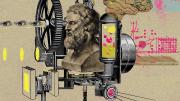“Intelligent,” “good at solving problems,” “innovative”: such words are often used to describe the capabilities of exceptional people. But what if being smart is less about a person’s innate intelligence, and more about the ability to tap into a form of collective intelligence: a shared, “cultural brain”? Based on a new understanding of human evolution, Moore professor of biological anthropology Joseph Henrich argues, contrary to conventional wisdom, that human brilliance emerges from the sharing of information in communities and networks across generations. Humans are uniquely engaged in collective information processing, he says, and this cultural intelligence is a key aspect of “what makes us human.”
Among the most ancient culturally transmitted practices is the preparation of food with fire. “I like to use this example because fire and cooking shaped our physiology and anatomy,” says Henrich. “We have much smaller stomachs than you would expect in primates of our size, and we have short colons,” too, because “cooking food is a form of pre-digestion.”
The use of tools is another example of a cultural trait that has influenced human genetics—specifically, selection for extremely dexterous hands. Humans are relatively weak primates: chimpanzees are perhaps five times stronger and have much denser bones. But humans don’t have to be as strong, he says, “because we have all these culturally evolved tools, technologies, and machinery that compensate for our weakness”—that require only fine motor skills and nimble fingers.
The threefold expansion of the size of the human brain during the last two million years, Henrich believes, was driven by the need to acquire, store, and organize cultural information: how to find medicinal plants, build houses, and fashion bone tools, for instance—all part of the vast body of knowledge that humans in pre-industrial societies need to survive. To persuade people that brain expansion in humans followed the need to spread cultural knowledge, rather than vice versa, he points to historic examples of what happened when European explorers were stranded and had to survive in places like the Arctic or Australia, far from their accustomed settings and communities. “Often, they couldn’t do basic things like find food, or travel, or make clothes. But there was always an Aboriginal group that could do all these things, and that had been living there for thousands of years—with no problem.” The reason the ostensibly sophisticated European explorer struggles while the indigenous population does not, he argues, “is that [humans] rely on a large bequest of culturally transmitted knowledge in a way that other animals don’t.”
Undeniably, Homo sapiens has adapted to vastly diverse environments, from the Arctic Circle to the equator—but not, Henrich points out, the way ants have, by developing 14,000 different species. Instead, “We’ve done it by cultural adaptation, using snow houses, kayaks, and harpoons in the north, but completely different technologies to survive elsewhere.”
As an explanation for human success, Henrich’s ideas integrate the sociobiological perspective of scientists like E.O. Wilson and the genetic evolutionary views favored by Stephen J. Gould. The pair famously butted heads; at the heart of their debates, Henrich explains, was the idea that humans continued to evolve until about 50,000 years ago, and then stopped. This, the thinking went, was followed by a period of sudden, exclusively cultural evolution. But Henrich believes these two forces—cultural and genetic—have been entwined for more than a million years. “The key intellectual insight,” he maintains, “is that human cultural capacities didn’t just pop up as a byproduct of intelligence but rather as a specialized product of natural selection.” Societies that best capture and transmit inherited culture enjoy greater success.
Gradually, at the level of the individual, an extended period of juvenile development evolved, enabling the brain to remain plastic and easily rewired so that people could acquire the vast quantities of accumulated knowledge that help them survive. At the group level, successful societies facilitated specialization and intergenerational transfer of intelligence and skills.
One of several corollaries to the cultural brain hypothesis is that larger, more interconnected populations amass cumulative cultural know-how at a faster rate. Evidence for this idea is abundant. Henrich cites studies of traditional tool technology in Polynesia and Oceania, which have found that larger, more populous islands (those with a bigger collective brain) had more sophisticated tools for marine foraging and fishing. Similarly, in the United Kingdom, when the government simplified the postal system in 1840 so that anyone could mail a letter for a penny, “There was a spike in innovation, because a lot more letters were zooming around.” In the early 20th century in the United States, IQ scores in rural towns “increased dramatically” whenever investment in schools, roads, and railroads connected these communities to the larger national “cultural brain.” Prohibition provides a counterexample: the shuttering of saloons led to a drop in innovation. That discovery was “non-intuitive,” Henrich notes, because one might expect that people would be “cognitively healthier without alcohol. But people were swapping ideas” and conceiving new ones in the saloons, leading to “a lot of innovation.”
Henrich and colleagues are currently studying language itself through the lens of cumulative cultural evolution. Human speech is sometimes described as a sudden innovation, perhaps enabled by a genetic change. But to Henrich, a gradual evolution seems more likely: “In the beginning, there were probably a couple of hand gestures and not much more. And then, through a cumulative process, humans developed more and more symbols—whether hand gestures or vocalizations—to begin to communicate ideas. Then comes a little bit of syntax: norms about how to combine sounds or gestures together.”
As language evolved and improved, that facilitated more cultural transmission that “confers advantages in the same way that telephones and letters increase the flow of cultural information,” Henrich believes. “So, language is endogenous to the process. It’s evolving as part of the system and not as a separate solution to the problem of communication”—that most human of traits.









